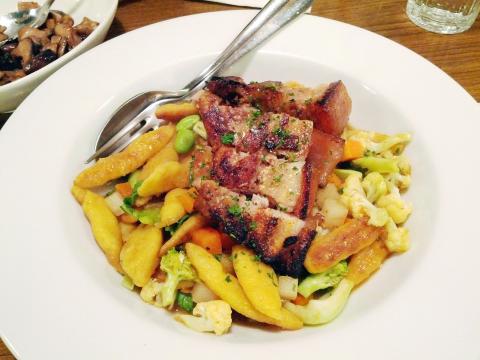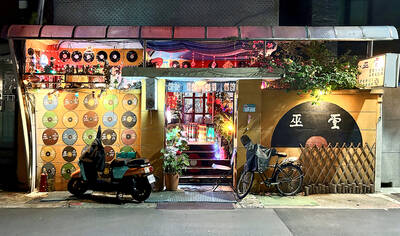Entering the Meowvelous Cafe and Restaurant (貓下去西餐快炒小館) feels like stumbling upon a well-kept secret. This intimate, cozy bistro serves French-style home cooking in an unlikely neighborhood, a quiet set of streets behind National Taiwan University Hospital, where little traffic passes through and lines of tall camphor trees stand, their leaves rustling gently on breezy days.
With its bright yellow neon sign, Meowvelous is one of the area’s few signs of life in the evenings, and on weekends it’s not uncommon to see a line of people outside waiting for a table, even in chilly winter weather. We showed up without reservations last Saturday and waited around 15 minutes, standing in a light, drizzling rain, and it was worth it. From start to finish, our meal was marvelous.
I had already been won over with the first sip of the restaurant’s soup of the day. The taste of this orange-red pureed concoction, which looked like a ho-hum cup of tomato soup, stopped us in our tracks. It was hearty with a complex mix of sweet and piquant flavors and a smoky aftertaste. The waiter almost seemed like he was waiting for us to ask him about the soup. He immediately smiled and rattled off the ingredients: apple, tomato paste, corn and a dash of Tabasco sauce.

Photo: David Chen , Taipei Times
We pondered this unusual but delightful alchemy while gazing at the half-dozen or so cooks working busily in the open kitchen. The restaurant, located in a long and narrow first-floor apartment, is divided into two halves, with diners lining one side and the kitchen and wait staff, all donning white shirts, on the other. The kitchen takes up half of the space, but the place feels cozy rather than claustrophobic. Meowvelous also sports a vague hipster vibe with indie rock and electronica piped through the house speakers, albeit at a reasonable volume.
The menu is fairly simple, with a selection of appetizers that average NT$250 per plate and include dishes such as pan-fried calamari with anchovy mayonnaise and shrimp and green pea with scrambled egg on crostini (small slices of grilled bread).
For main courses, there’s a handful of pasta and risotto dishes, which run between NT$260 to NT$380. For bigger appetites, there are several meat main courses for NT$580, which include an 8oz grilled steak and fries, the restaurant’s nod to the classic French dish steak frites, and “pan roast free range chicken” with sauteed vegetables.
On our visit, I went for one of the daily specials, roast belly pork (烤豬五花) with curried potato dumplings and sauteed vegetables (NT$560), which was pure comfort on a plate. The pork was sumptuous while the perfectly chopped bits of broccoli, carrot, cauliflower and edamame beans had a buttery flavor. The potato dumplings had a sweet zing from the curry and a nice, chewy texture to offset the melt-in-your-mouth softness of the roast pork.
My dining companion ordered the carrot and apple risotto with mixed vegetables, bacon and hash brown (NT$300). From the few bites I had, I felt it was a tad bit too sweet, but the dish was prepared well. The risotto was cooked to a proper, creamy consistency, and although unusual, the crispy hash brown was a nice accompaniment.
Meowvelous does well with simple dishes such as the sauteed mushrooms (NT$120), a mix of fresh shitake and white button mushrooms cooked with fresh herbs and white wine. One item I’m looking forward to trying is the club sandwich with fries (NT$260). It looked scrumptious in photos posted on Meowvelous’ Facebook page, which happens to be a good place to get a glimpse of the beautiful presentation of its meals.
Meowvelous, which is only open in the evenings, also makes for a nice place to have a drink, with an extensive selection of cocktails (NT$150 to NT$180), imported bottled beers from Belgium and Germany (NT$180) and wines at NT$200 a glass or NT$900 a bottle.
Our meal ended as brilliantly as it began, with a tangy and creamy lemon tart pudding (NT$100) that already had me anticipating my next visit.
The restaurant seats around 25 persons. Reservations are recommended and limited to parties of up to four persons.

The Lee (李) family migrated to Taiwan in trickles many decades ago. Born in Myanmar, they are ethnically Chinese and their first language is Yunnanese, from China’s Yunnan Province. Today, they run a cozy little restaurant in Taipei’s student stomping ground, near National Taiwan University (NTU), serving up a daily pre-selected menu that pays homage to their blended Yunnan-Burmese heritage, where lemongrass and curry leaves sit beside century egg and pickled woodear mushrooms. Wu Yun (巫雲) is more akin to a family home that has set up tables and chairs and welcomed strangers to cozy up and share a meal

Dec. 8 to Dec. 14 Chang-Lee Te-ho (張李德和) had her father’s words etched into stone as her personal motto: “Even as a woman, you should master at least one art.” She went on to excel in seven — classical poetry, lyrical poetry, calligraphy, painting, music, chess and embroidery — and was also a respected educator, charity organizer and provincial assemblywoman. Among her many monikers was “Poetry Mother” (詩媽). While her father Lee Chao-yuan’s (李昭元) phrasing reflected the social norms of the 1890s, it was relatively progressive for the time. He personally taught Chang-Lee the Chinese classics until she entered public

Last week writer Wei Lingling (魏玲靈) unloaded a remarkably conventional pro-China column in the Wall Street Journal (“From Bush’s Rebuke to Trump’s Whisper: Navigating a Geopolitical Flashpoint,” Dec 2, 2025). Wei alleged that in a phone call, US President Donald Trump advised Japanese Prime Minister Sanae Takaichi not to provoke the People’s Republic of China (PRC) over Taiwan. Wei’s claim was categorically denied by Japanese government sources. Trump’s call to Takaichi, Wei said, was just like the moment in 2003 when former US president George Bush stood next to former Chinese premier Wen Jia-bao (溫家寶) and criticized former president Chen

President William Lai (賴清德) has proposed a NT$1.25 trillion (US$40 billion) special eight-year budget that intends to bolster Taiwan’s national defense, with a “T-Dome” plan to create “an unassailable Taiwan, safeguarded by innovation and technology” as its centerpiece. This is an interesting test for the Chinese Nationalist Party (KMT), and how they handle it will likely provide some answers as to where the party currently stands. Naturally, the Lai administration and his Democratic Progressive Party (DPP) are for it, as are the Americans. The Chinese Communist Party (CCP) is not. The interests and agendas of those three are clear, but